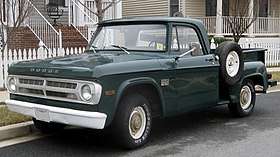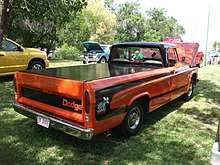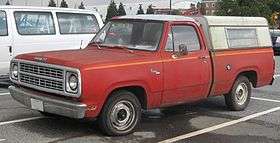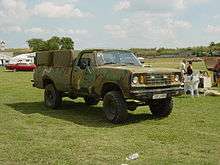Dodge D series
| Dodge D/W series | |
|---|---|
 | |
| Overview | |
| Manufacturer | Chrysler Corporation |
| Production | 1961–1993 |
| Assembly |
Warren Truck Assembly, Warren, Michigan, United States São Caetano do Sul, Brazil Windsor Assembly, Canada Bogotá, Colombia (1969-1976) |
| Body and chassis | |
| Class | Full-size pickup truck |
| Body style |
2-door truck 4-door truck |
| Layout |
Front engine, rear-wheel drive Front engine, four-wheel drive |
| Platform | Chrysler AD platform |
| Chronology | |
| Predecessor | Dodge C series |
| Successor | Dodge Ram (newer platforms have "D" prefixed in its identity) |
The D/W series was a line of pickup trucks that was sold by Dodge from 1961 to 1993. The same basic design was retained until the 1994 introduction of a completely redesigned Ram. The D/W series shared its AD platform with the Dodge Ramcharger/Plymouth Trailduster twins. 4x2 models were designated D, while 4x4 models were designated W.
First generation (1961–65)
| First generation | |
|---|---|
.jpg) 1961 Dodge 100 | |
| Overview | |
| Production | 1961–1964 |
| Body and chassis | |
| Body style |
2-door pickup truck 4-door pickup truck |
| Powertrain | |
| Engine |
318 cu in (5.211 l) Chrysler A engine |
| Transmission |
3-speed manual |
| Dimensions | |
| Wheelbase |
114 in (2,896 mm) (regular cab 6.5 ft (2.0 m) bed) 122 in (3,099 mm) (regular cab 8 ft (2.4 m) bed)[1] 133 in (3,378 mm) (regular cab 9 ft (2.7 m) Utiline bed) 146 in (3,708 mm) (crew cab 6.5 ft (2.0 m) bed) |
The Chrysler A engine of 318 cu in (5.211 l) was the smallest V8 option; and all of Chrysler's larger engines, with the notable exception of the Chrysler Hemi engine, were available as factory options.
Besides straight-sided beds (called Sweptline), the D series also offered step-sided narrow beds (called Utiline) in 6.5 ft (2.0 m) (D-100 only), 8 ft (2.4 m) (D-100 and 200), and 9 ft (2.7 m) (D-300 only) lengths.
The first generation of the D series was manufactured in Warren, Michigan. They were given the Dodge and Fargo brands. The trucks were produced by the Dodge Division of the Chrysler Corporation.
Custom Sports Special and high-performance package
1964 saw the introduction of the sporty Custom Sports Special. The Custom Sports Special included bucket seats, console, carpeting and racing stripes. The optional high-performance package could be ordered with a CSS truck or by itself on a base model truck complete with Chrysler's big 426 cu in (6.981 l) wedge-head V8. This engine produced 365 hp (272 kW) and 470 lb·ft (637 N·m)—in line with the muscle-car revolution that was then sweeping Detroit. The high-performance package also included the LoadFlite automatic transmission, a 6000 rpm-rated Sun tachometer with heavy-duty gauges, power steering, dual exhaust and rear axle torque rods (traction bars) sourced from 1961 Imperials. Custom Sports Special trucks were produced from 1964 to 1967[2]. The High Performance Package was only offered from 1964 to early 1966.
Second generation (1965–71)
| Second generation | |
|---|---|
 | |
| Overview | |
| Production | 1965–1971 |
| Body and chassis | |
| Body style |
2-door pickup truck 4-door pickup truck |
| Powertrain | |
| Engine |
368 cu in B B 383 cu in B B 421 cu in RB V8 461 cu in RB V8 440 cu in B V8 361 cu in B V8 |
| Transmission | |
| Dimensions | |
| Wheelbase |
114 in (2,896 mm) (regular cab 6.5 ft (2.0 m) bed) 128 in (3,251 mm) (regular cab 8 ft (2.4 m) bed) 133 in (3,378 mm) (regular cab 9 ft (2.7 m) Utiline bed) 146 in (3,708 mm) (crew cab 6.5 ft (2.0 m) bed) |
1965–67
The D series was mildly redesigned in spring of 1965, hence there are both two-headlight and four-headlight models titled as 1965s. Updates for mid-'65 included a wider tailgate and the replacement of the A-series engines with the updated LA series, as well as a six-inch wheelbase stretch on 8 ft (2.4 m) bed models. In 1967, the D-series trucks received big-block 383 2-barrel engines as a standard option.
From 1965 until the early 80s, D-series trucks were assembled in Warren, Michigan by the Chrysler Corporation. Foreign models were manufactured by the Automotive Equipment Group (מכשירי תנועה בע"מ) in Israel at a new factory located at Nazareth-I'llit: Automotive Industries (תעשיות רכב נצרת-עלית), using straight-four and -six gasoline engines with manual transmission. This factory also produced the Jeep Wagoneer SUV for the Israeli army, and UK Ford Escort and Ford Transit vehicles for the civilian market. The D series were made both for the civilian market and for the Israeli army. The models were D100 & D200 light trucks, D500 truck, and the D600 truck with the straight-six engine and having on-demand four-wheel drive. There was also a bus version made (mainly for army use). This bus was a 20-seat bus built on the chassis of the D500 truck using the straight-four engine with front and rear hydraulic doors, as well as the complete D500 front end and dashboard.
1968–71

The 1968 models received a new front grille—two rows of four holes each. A new Adventurer trim package replaced the old Custom Sports Special; basically, it included a padded front seat with vinyl trim (either full bench or buckets with console) and carpeting, plus other hallmarks such as extra chrome trim and courtesy lighting. This generation continued to be built in South Africa as well. Sold as the D300 or the D500, the lighter model received the 225 Slant-Six, while the heavier-duty D500 has the 318 ci V8. Power outputs are 127 and 177 hp (95 and 132 kW) (net) respectively, SAE claims are 140 and 212 hp.[3]
By 1970, the Adventurer would be expanded into three separate packages: the base Adventurer, the Adventurer Sport and the top-line Adventurer SE. The Adventurer SE included such things as a chrome grille, wood trim on the dashboard, the padded vinyl front seat with color-keyed seatbelts, full courtesy lighting, extra insulation, dual horns, full carpeting, luxury door panel trim, a vinyl-embossed trim strip ran along the sides of the truck, full wheel discs and a woodgrain-insert panel on the tailgate. The 1970 models also featured a new four-section grille (two rows of two holes each).

"The Dude"
In August 1969, the "Dude Sport Trim Package" was released. This was essentially the D100 already in production, with an added black or white body-side "C" stripe decal; a Dodge Dude decal on the box at the rear marker lamps; tail lamp bezel trim; and dog dish hub caps with trim rings. The Dude's tailgate was unique, featuring a Dodge decal on a flat tailgate surface, without the typical tailgate’s embossed logo. The Dudes were only offered in the 1970 and 1971 model years and only 1500 to 2000 Dudes were produced.[4][5]
Third generation (1972-80)
| Third generation | |
|---|---|
 | |
| Overview | |
| Production | 1972–1980 |
| Body and chassis | |
| Body style |
2-door pickup truck 2-door extended cabpickup truck 4-door pickup truck |
| Powertrain | |
| Engine | |
| Transmission | |
| Dimensions | |
| Wheelbase |
115 in (2,921 mm) (regular cab 6.5 ft (2.0 m) bed) |
A redesign of the D series for 1972 introduced a more rounded look. This redesign, which lasted until 1980 with minor changes, included new features such as an independent front suspension and pocketed taillights (the distinctive reverse-on-top lights were recessed to .25 in (6.4 mm) to avoid damage in loading docks and confined spaces). Styling cues, such as the scalloped hood and rounded fenderwells, were similar to the rounded, smooth look of the 1971 Plymouth Satellite. These trucks were built with a considerable amount of galvanized steel to resist rust and corrosion, making them very durable.
Dodge pioneered the extended-cab pickup with the introduction of the Club Cab with the 1973 models. Available with either a 6.5 ft (2.0 m) or 8 ft (2.4 m) Sweptline bed, the Club Cab was a two-door cab with small rear windows which had more space behind the seats than the standard cab, but not as long as the four-door crew cab. Inward-facing jump seats were available, providing room for 5 passengers. 1974 saw the introduction of the 440 cu in engine as an option for the light trucks, as well as a "Dyna-Trac" dual-rear-wheel option on D300 pickups with a 10,000 lb (4,500 kg) GVWR.
The 1972 D series was made famous in the television show Emergency!, where a D300 chassis-cab was the featured paramedic rescue squad vehicle for all seven seasons.

Notable models produced during this era were the 1978–1979 Li'l Red Express, the Warlock, the Macho Power Wagon, the Macho Power Wagon Top Hand, Macho Power Wagon Palomino, and the Adventurer. The colors of the Dodge Macho Power Wagon Palomino were the same as a Palomino horse (all Li'l Red Express trucks were Adventurers, though not vice versa). Another rare model is the Midnite Express, which was available for the 1978 model year only. This truck was equipped much like the Li'l Red Express with exhaust stacks, wheels, and gold pinstriping. The Midnite Express was painted black instead of red and featured a "Midnite Express Truck" decal on the door. Most Midnite Express trucks were powered by the 440 engine, instead of the 360 like the Li'l Red Express. All of these trucks were considered "lifestyle" pickups and were marketed to an audience that wanted specialty, personal use trucks.
The 1978 models also saw the introduction of the first Diesel powered Dodge pickup truck. Available as an economy choice in light-duty trucks and B-series vans was Mitsubishi's 6DR5 4.0 L inline six-cylinder naturally-aspirated diesel, rated at 105 hp (78 kW) at 3500 rpm, and ~230 N·m (~169 lb·ft) at 2200 rpm. The diesel used standard Dodge manual and automatic transmissions via specially made adapter plate which had the LA V8 bolt pattern. This rare factory option, VIN code H, was the result of fuel crisis and the collaboration of Chrysler and Mitsubishi.[6] The engine, while being trustworthy and having far better economy than any other engine in the Dodge lineup at the time, suffered from low power output and was considered to be underpowered by American standards, even though it was previously used in the Japanese 3.5-ton cab-over Mitsubishi T44 Jupiter Truck and in industrial applications. Because of the low sales, it was phased out quickly, and as a result, it became practically a single-year specialty.

Thousands of D-series trucks entered military service as the M880 series CUCV.
Dodge Ram (1981–93)

This final generation was face lifted in 1981 when the D series was a rebadge as the Dodge Ram pickup around when Lee Iacocca took charge of the ailing Chrysler Corporation. Such things including an embossed "DODGE RAM" name on the tailgate along with other obvious changes like the grille and hood, the taillights, and the entire interior. More subtle was the addition of a "shoulder" line reminiscent of the GM competition. Beginning in 1982, even more corrosion-resistant steel was used in the construction of the trucks. This body style continued until 1993 and many of these vehicles are still on the road. Many body panels are interchangeable for all models from 1972–1993, so it is not uncommon to see a "hybrid" with, as an example, a 1978 grille mounted with a 1974 hood and a 1991 cab. Sometimes the bed is swapped with a moving truck style box for models like these. In most jurisdictions, the year is dictated by the year of the truck's chassis regardless of the body which has been bolted to it. Also kept was the narrow Utiline bed that dated back to the 1940s; this was dropped in 1985. Throttle-body injection was introduced in 1988.
A narrower range of engines was offered: the base power plant was the 225 cu in (3.7 L) slant-6, now with top-fed hydraulic tappets, and the 318 cu in (5.2 L) and 360 cu in (5.9 L) LA-series V8s. The slant-6 was supplanted by the 3.9 L (237 cu in) V6 for 1988; in 1992 it and the V8s became Magnum engines. The 6BT 5.9 L (360 cu in) 12-Valve Cummins B-series diesel engine became an option in 1989.
Sales were good during the Sweptline era and into the late 1970s. A combination of stagnant styling nearly two decades old plus brand loyalty primarily to Chevrolet and Ford during the 1980s and 1990s reduced sales volume for the first generation Dodge Ram. A wholly new Dodge Ram was released for the 1994 model year.
Engines
- 1967–1993 318 cu in (5.2 L) LA V8
- 1961–1970 361 cu in Chrysler B engine V8
- 1971–1993 360 cu in (5.9 L) LA V8, 175 hp and 285 lb·ft of torque (ratings for 2-Bbl carb version)[7]
- 1963–1971 383 cu in (6.3 L) B V8, 245 hp (187 kW) net
- 1972–1979 400 cu in B V8, 245 hp (187 kW) net
- 1961–1979 413 cu in RB V8, 255 hp (194 kW) net (typ. ratings for 2-Bbl carb version)
- 1963–1966 426 cu in RB V8, 260 hp (149 kW) net (275 hp 76–77)
- 1966–1977 440 cu in (7.2 L) RB V8, 255 hp (228 kW) net
- 1978–1979 4.0 L Mitsubishi 6DR50A naturally-aspirated I6, 105 hp @ 3500 rpm and 169 lb·ft (230 N·m) of torque
- 1960–1987 225 cu in (3.7 L) RG Slant 6, 105 hp and 180 lb·ft of torque [8]
- 1960–1967 170 cu in (2.8L) RG Slant 6, 105 hp and 180 lb·ft of torque [8]
- 1988–1993 239 cu in (3.9 L) LA V6, 180 hp (134 kW) and 195 lb·ft (264 N·m)
- 1989–1993 358 cu in (5.9 L) Cummins B-series engine I6, 160 hp (119 kW) and 400 lb·ft (542 N·m) of torque
In Brazil, the only available engine was the 318 cu in (5.2 L) V8.
See also
Notes
- ↑ "Directory Index: ChryslerTrucksVans/1963_Trucks_and_Vans/1963_Dodge_Truck_Brochure". Oldcarbrochures.com. Retrieved 2012-05-31.
- ↑ "1964 CSS sales brochure". www.cssregistry.com. Retrieved 2018-07-11.
- ↑ Dodge D300 and D500 (brochure), Pretoria, South Africa: Chrysler South Africa, 1971, pp. 3–4
- ↑ http://www.allpar.com/trucks/dodge/dude.html
- ↑ http://www.dodgedude.com/index.php
- ↑ Niedermeyer, Paul (2012-11-26). "The Case Of The Very Rare 1978 Dodge Diesel Pickup And The Missing Diesel Van". Automotive History. Curbside Classics. Retrieved 2014-05-13.
- ↑ AHinsey
- 1 2 AHinsey
External links
| Wikimedia Commons has media related to Dodge D Series. |
- 1961–71 Dodge Truck Website (Medium & Heavy Duty Trucks)
- Old Dodges.com (Medium & Heavy Duty Dodges)
Dodge truck timeline, North American market, 1970s–present | ||||||||||||||||||||||||||||||||||||||||||||||||||
|---|---|---|---|---|---|---|---|---|---|---|---|---|---|---|---|---|---|---|---|---|---|---|---|---|---|---|---|---|---|---|---|---|---|---|---|---|---|---|---|---|---|---|---|---|---|---|---|---|---|---|
| Type | 1970s | 1980s | 1990s | 2000s | 2010s | |||||||||||||||||||||||||||||||||||||||||||||
| 0 | 1 | 2 | 3 | 4 | 5 | 6 | 7 | 8 | 9 | 0 | 1 | 2 | 3 | 4 | 5 | 6 | 7 | 8 | 9 | 0 | 1 | 2 | 3 | 4 | 5 | 6 | 7 | 8 | 9 | 0 | 1 | 2 | 3 | 4 | 5 | 6 | 7 | 8 | 9 | 0 | 1 | 2 | 3 | 4 | 5 | 6 | 7 | 8 | 9 | |
| Mid-size CUV | Journey | |||||||||||||||||||||||||||||||||||||||||||||||||
| Compact SUV | Raider | Nitro | ||||||||||||||||||||||||||||||||||||||||||||||||
| Mid-size SUV | Durango | |||||||||||||||||||||||||||||||||||||||||||||||||
| Full-size SUV | Ramcharger | Ramcharger‡ | Ramcharger‡ | Durango | Durango | |||||||||||||||||||||||||||||||||||||||||||||
| Coupé utility | Rampage | |||||||||||||||||||||||||||||||||||||||||||||||||
| Minivan | Caravan | CV/GCV | CV/GCV | CV/GCV | CV/GCV | Grand Caravan | ||||||||||||||||||||||||||||||||||||||||||||
| Van | A100 | Tradesman | Ram Van/Ram Wagon | Ram Van/Ram Wagon | Ram | |||||||||||||||||||||||||||||||||||||||||||||
| Sprinter | Sprinter | |||||||||||||||||||||||||||||||||||||||||||||||||
| Compact pickup | D-50 | Ram 50 | Ram 50 | |||||||||||||||||||||||||||||||||||||||||||||||
| Mid-size pickup | Dakota | Dakota | Dakota | |||||||||||||||||||||||||||||||||||||||||||||||
| Full-size pickup | D Series | D Series | Ram (D Series) | Ram | Ram | Ram | ||||||||||||||||||||||||||||||||||||||||||||
| Ram SRT-10 | ||||||||||||||||||||||||||||||||||||||||||||||||||
| Heavy-duty truck | LCF/C Series | |||||||||||||||||||||||||||||||||||||||||||||||||
| Notes: | ‡The Ramcharger was not sold in the United States after the 1994 model year. | |||||||||||||||||||||||||||||||||||||||||||||||||
| After Fiat S.p.A. acquired Chrysler LLC in 2009, models of trucks and cargo vans were no longer designated as Dodge, but exclusively as Ram. A timeline of these models can be found here. | ||||||||||||||||||||||||||||||||||||||||||||||||||